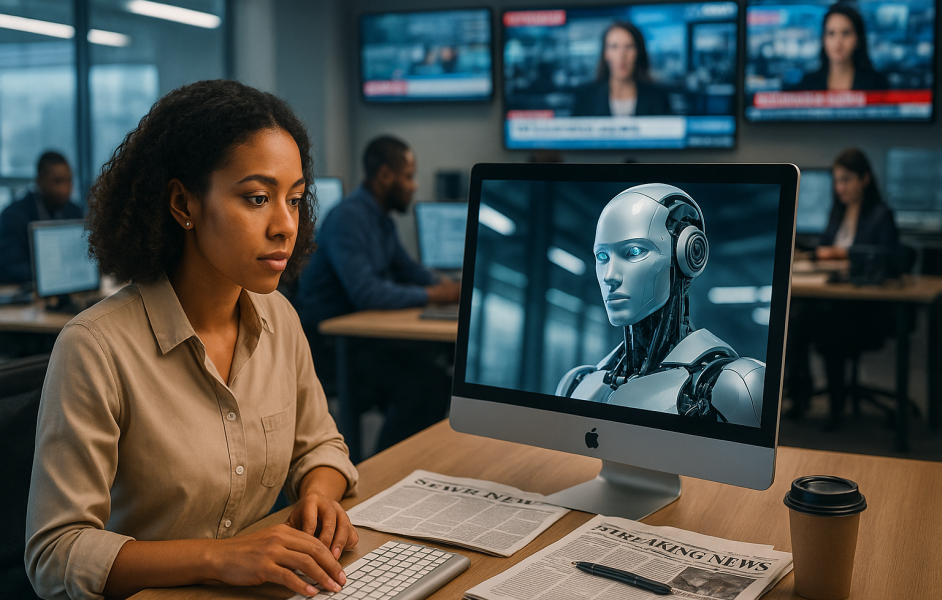Robotics News
Medium
98

Image Credit: Medium
HardTech Reads: The AI & Robotics Revolution vol.34
- 1930s Japan's steel humanoid robot resurfaces in history books, while Waymo expands to San Jose, Houston, and more cities.
- U.S. factory output decreases for the 3rd consecutive month, posing a potential risk of recession.
- China's rare earth export freeze disrupts global EV production lines, impacting industries like robotics and defense.
- The Congressional Robotics Caucus reemerges in Washington to drive U.S. competitiveness and focus on ethics, education, and R&D.
- Amazon tests humanoid robots for package delivery, aiming to revolutionize the delivery industry.
- Walmart and Wing collaborate to launch drone delivery services in over 100 U.S. stores, marking a significant scaling phase.
- Various AI and robotics companies secure substantial funding to advance technologies in construction, marine autonomy, and workforce tools.
- Impulse Space secures $300M Series C for in-space mobility, while Walmart and Wing expand drone delivery services across U.S. stores.
- The HardTech Jobs Board highlights job opportunities in companies like Figure, SpaceX, Boston Dynamics, and more.
- Upcoming events in the AI and robotics sector include tech summits, hackathons, and conferences worldwide.
Read Full Article
5 Likes
Unite
148

Image Credit: Unite
Why Meta’s Biggest AI Bet Isn’t on Models—It’s on Data
- Meta's $10 billion investment in Scale AI indicates a strategic shift towards prioritizing data over AI models in the tech industry.
- Scale AI's revenue growth has surged, reaching from $870 million to $2 billion in a year, with a valuation trajectory of $7 billion to $13.8 billion.
- Meta aims to secure exclusive datasets to gain a competitive edge post the underwhelming response to Llama 4.
- Scale AI is positioned as a data foundry, emphasizing high-quality data pipelines for AI training through a hybrid automation-human expertise model.
- Meta's focus on data infrastructure control rather than model sophistication sets it apart from competitors like Microsoft and OpenAI.
- The partnership between Meta and Scale AI extends to government projects like Defense Llama, bridging commercial AI with national security developments.
- Meta's investment challenges the dominant Microsoft-OpenAI partnership model, emphasizing foundational data infrastructure control over model collaborations.
- Scale AI's revenue growth and valuation signify the market demand for professional AI data services and the strategic importance of data infrastructure.
- Meta's investment suggests a trend of vertical integration in AI infrastructure, emphasizing the significance of data quality and model alignment services.
- This strategic pivot towards data infrastructure control signifies the beginning of a 'data wars' era, where high-quality datasets are key to AI leadership.
Read Full Article
8 Likes
Medium
24

Image Credit: Medium
Developing artificial intelligence to help treat diseases
- The future of healthcare involves implementing artificial intelligence into primary medical consultation centers like local pharmacies.
- A human-like robot at the pharmacy would provide preliminary diagnoses, suggest medication, print detailed usage instructions, and offer tips for better recovery based on input from patients.
- AI would be programmed to ensure precision diagnosis, offer empathetic phrases, handle emergencies responsibly, mitigate errors, maintain organizational and legal accountability, prioritize security and privacy, and continuously update medical information.
- The AI pharmacy robot aims to provide a user-friendly design for trust and comfort, advanced diagnostic capabilities, and build public trust over time through continuous development and improvement.
Read Full Article
1 Like
The Robot Report
265

HEBI Robotics gets SBIR grant to develop hardware for hazardous environments
- HEBI Robotics received a $250,000 Small Business Innovation Research (SBIR) grant from the U.S. Army to develop hardware for hazardous environments.
- The company plans to create modular building blocks and tools to reduce the time and expense for building full robots certified for hazardous workspaces.
- The grant will enable HEBI Robotics to develop Class I, Division 1-certified robots capable of operating in environments with explosive and volatile materials.
- If successful, this project could lead to further collaboration and expanded funding for full-scale production, with the aim to enhance safety in military and industrial applications.
Read Full Article
15 Likes
Discover more
Unite
437

Image Credit: Unite
AI Liability Insurance: The Next Step in Safeguarding Businesses from AI Failures
- AI is crucial for many businesses, but it poses unique risks that traditional insurance does not cover adequately.
- AI failures can lead to costly lawsuits, fines, and reputational damage, highlighting the need for AI liability insurance.
- AI liability insurance addresses financial and legal issues arising from AI failures, biases, and errors.
- The rise of AI in various industries has increased the demand for AI liability insurance to manage new risks.
- AI risks include hallucinations, model drift, data poisoning, privacy concerns, and ethical issues.
- Real-world cases demonstrate the legal, financial, and reputational consequences of AI failures.
- AI liability insurance covers failures, misleading outputs, data breaches, fines, and legal costs related to AI.
- Insurance companies like Coalition, Relm, Munich Re, AXA XL, and Chaucer Group offer AI liability products to meet evolving needs.
- Financial protection, legal defense coverage, customization options, and regulatory compliance are key features of AI liability insurance.
- Businesses in healthcare, finance, autonomous vehicles, marketing, and cybersecurity are advised to consider AI liability insurance to mitigate risks.
Read Full Article
26 Likes
Livescience
278

Image Credit: Livescience
Robots run out of energy long before they run out of work to do — feeding them could change that
- Robots, despite their agility and efficiency, still struggle with endurance due to energy limitations, often running out of power before completing tasks.
- Current mobile robots rely on lithium-ion batteries, which have slow performance improvements, hindering their endurance capabilities.
- To match the endurance of animals like sled dogs, robots would need batteries dozens of times more powerful than current lithium-ion ones.
- Fast charging and energy harvesting methods like solar power have limitations in meeting the energy demands of highly mobile robots.
- New battery chemistries such as lithium-sulfur offer higher energy densities, but face challenges like degradation over time and difficulties in real-world applications.
- Researchers are exploring the concept of 'robotic metabolism' where robots could 'eat' high-energy materials like aluminum to generate electricity, mimicking how animals convert food into energy.
- By developing synthetic metabolisms and fluid-based energy systems inspired by biological systems, robots could potentially operate for longer durations and be more adaptable and lifelike.
- For robots to work effectively alongside humans in various roles, improving their endurance through innovative energy solutions is essential.
- Enhancing robots' energy systems is crucial for their ability to perform tasks in disaster zones, farms, warehouses, hospitals, and other settings requiring sustained activity.
- Building robots with synthetic metabolisms could not only increase their endurance but also make them more resilient and capable of self-regulation and self-repair.
- Innovations in energy technologies and approaches could lead to robots that are not only intelligent and agile but also have the stamina to operate effectively over extended periods.
Read Full Article
16 Likes
The Robot Report
189

Saildrone, Meta complete robotic deep-water cable route survey
- Saildrone Inc., in partnership with Meta, completed a deep-water cable route survey using the 20-m uncrewed surface vehicle, Saildrone Surveyor.
- The demonstration showed that autonomous platforms can provide data quality comparable to traditional crewed survey vessels while reducing risk and cost.
- The 26-day survey in the North Atlantic mapped over 4,500 km of seabed with exceptional accuracy and without outside assistance.
- The success of the mission opens the door for wider adoption of USVs in various industries and highlights the sustainable advantages of uncrewed systems.
Read Full Article
11 Likes
The Robot Report
31

Wandercraft unveils Calvin, new industrial humanoid, and Renault partnership
- French robotics company Wandercraft, known for its exoskeletons, unveiled its first humanoid robot called Calvin designed for industrial use.
- Renault has made a minority investment in Wandercraft, aiming to develop Calvin as part of next-generation robots for industrial applications to enhance productivity and reduce worker strain.
- Wandercraft's primary product is the Atalante X exoskeleton, used for rehabilitation purposes, and they have also introduced the Personal Exoskeleton for personal, everyday use.
- Renault's partnership with Wandercraft will help in commercializing robots and exoskeletons, enabling the introduction of new business opportunities and technologies in the field of robotics.
Read Full Article
1 Like
TechCrunch
54

Image Credit: TechCrunch
Tesla’s Optimus robot VP is reportedly leaving the company
- Milan Kovac, the head of Tesla's Optimus humanoid robot program, is reportedly leaving the company.
- Tesla CEO Elon Musk aims to have 'thousands' of Optimus robots in their factories by the end of the year and scale up production rapidly.
- Kovac, who has been at Tesla for nearly 10 years, played a significant role in leading the development of Optimus since 2022.
- Ashok Elluswamy, the vice president of Tesla's AI software division, is set to take over the Optimus project following Kovac's departure.
Read Full Article
3 Likes
Unite
288

Image Credit: Unite
Building Confidence in AI: Training Programs Help Close Knowledge Gaps
- Despite AI reshaping the workforce rapidly, only 12% of workers received AI-related training in the past year, leading to uncertainty and job impact concerns.
- AI is meant to augment, not replace, employee skill sets, focusing on enhancing productivity and competitiveness.
- Employees require proper training to understand AI to avoid issues like data privacy concerns, bias, and inaccuracies.
- Upskilling and cross-skilling are vital to help employees adapt to AI and unlock its full potential.
- Upskilling strengthens existing skills, while cross-skilling develops new skills applicable across functions, both essential in AI adoption.
- Training employees in AI boosts engagement, satisfaction, and helps in retaining top talent in a competitive market.
- 79% of learning and development professionals believe reskilling current employees is more cost-effective than hiring new ones in the age of AI.
- To start upskilling and cross-skilling, organizations can assess current skillsets, set attainable goals, rethink learning formats, prioritize responsible AI, and monitor progress.
- Employees are key to the success of AI implementation, and having a foundation of AI knowledge benefits both career growth and organizational success.
- Focusing on upskilling and cross-skilling to create an AI-centric culture can lead to improved engagement, talent retention, and competitive advantage.
Read Full Article
17 Likes
Unite
315

Image Credit: Unite
When Your AI Invents Facts: The Enterprise Risk No Leader Can Ignore
- Generative AI models often hallucinate, leading to incorrect information and a lack of self-awareness about errors in legal and academic domains.
- AI-generated content has been linked to increased risks in finance, such as disinformation leading to potential bank runs.
- Misinformation and disinformation, propelled by AI, are highlighted as top global risks in the World Economic Forum Global Risks Report.
- Studies show a wide range of hallucination rates in AI models, emphasizing the need for caution and thorough evaluation prior to enterprise adoption.
- AI's potential for generating fake content poses risks of market crises, political instability, and fraud, as evidenced by instances like the G20's Financial Stability Board flagging generative AI as a vector for disinformation.
- Enterprises should approach AI adoption with caution, particularly in regulated industries, as errors from AI-generated content could have severe consequences.
- Companies focusing on building enterprise-safe AI models prioritize transparency, explainability, and traceability to mitigate risks associated with hallucinations in AI outputs.
- The EU's AI Act sets standards for regulating high-risk domains like justice and healthcare to ensure AI accountability through documentation, testing, and explainability.
- An accountable approach to AI adoption involves mapping AI usage, establishing robust governance structures, integrating AI risk management at a board level, and holding vendors accountable for AI performance.
- Building trustworthy AI models involves prioritizing precision, transparency, trust, and accountability over simply scaling up model sizes for enterprise integration.
Read Full Article
18 Likes
Unite
292

Image Credit: Unite
How AI Might Save the News Media
- As AI technologies continue to advance, there is a fear that they may replace journalists and other content creators in the news media industry.
- Some newsrooms have already started experimenting with AI to automate news generation, leading to concerns among journalists about potential job loss.
- However, incidents of inaccuracies in AI-generated content published by companies like CNET and G/O Media have raised doubts about the complete replacement of human journalists by AI.
- AI is more likely to assist news publications rather than completely replace journalists, potentially enhancing the quality of news content.
- Large Language Models require high-quality training content, with news organizations providing valuable and reliable information for AI training.
- Major media companies like The New York Times are taking legal actions and blocking AI crawlers from accessing their content, signaling concerns about AI's impact on the industry.
- AI companies and media institutions are starting to form partnerships to utilize each other's strengths, aiming to provide consumers with well-researched information.
- Getting into the dataset of major AI models is becoming crucial for businesses, as consumers increasingly rely on AI assistants for specialized content.
- Optimizing content to be included in AI training datasets is likened to a new form of SEO, highlighting the growing importance of being featured in high-quality news media publications for visibility.
- AI's role in news media is evolving, with collaborations between AI labs and media companies shaping the future of information dissemination and consumption.
Read Full Article
17 Likes
IEEE Spectrum
94

Image Credit: IEEE Spectrum
Video Friday: Hopping on One Robotic Leg
- Video Friday features a selection of robotics videos, along with a calendar of upcoming robotics events.
- A single-leg robot showcased for its bipedal development potential was highlighted in the videos.
- Aldebaran's success in selling 17,000 social robots was mentioned, expressing amazement.
- Various robotics innovations and demonstrations, including tactile sensing for quadrupedal robots and mobile manipulation tasks, were featured in the videos.
Read Full Article
5 Likes
The Robot Report
58

Webinar to discuss advances in mobile robots for warehouses
- Vanderlande and Hai Robotics are collaborating on mobile robots for warehouses to handle cases and totes.
- Warehouse operators are increasingly turning to automation, including mobile robots, to enhance efficiency and speed up order fulfillment in response to customer demand, labor shortages, and trade disruptions.
- A free webinar on June 10, 2025, at 12:00 p.m. EDT will address considerations for adopting, scaling, and managing fleets of automated guided vehicles (AGVs), self-driving forklifts, and autonomous mobile robots (AMRs).
- Industry experts will discuss how the latest mobile robots are improving productivity, inventory management, safety, and how they work with existing processes and staff members.
Read Full Article
3 Likes
For uninterrupted reading, download the app